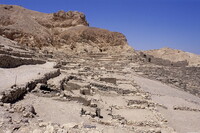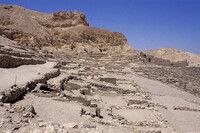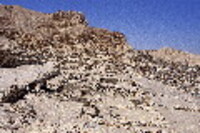| dc.coverage.spatial | Site: Dayr al-Madinah (Thebes, Upper Egypt, Egypt) | en_US |
| dc.coverage.temporal | | en_US |
| dc.creator | unknown (Egyptian (ancient)) | en_US |
| dc.date.accessioned | 2013-04-23T18:50:10Z | |
| dc.date.available | 2013-04-23T18:50:10Z | |
| dc.date.issued | 2013-04-23 | |
| dc.identifier | 209993 | en_US |
| dc.identifier.other | archrefid: 757 | en_US |
| dc.identifier.uri | http://hdl.handle.net/1721.3/118018 | |
| dc.description | General view of the village remains, looking north, with girdle wall of Ptolemaic temple in background; Deir el-Medina [Arabic: 'Monastery of the village']. Site of a village in a small valley towards the south end of the Theban necropolis, on the west bank of the Nile. There are a few traces of occupation in the Middle Kingdom, but the site was at its peak in the New Kingdom. In the Coptic period (ca. 3rd-7th century CE) a monastery was built at the northern end of the site; this gave rise to its modern name. During the New Kingdom the village housed the officials, artists, craftsmen and labourers responsible for the excavation and decoration of the royal tombs of the period. The village reached its greatest extent during the Ramesside period. Its rectangular enclosure wall contained 68 dwellings. Surrounding the village on the west and north were the terraced cemeteries and local chapels built by the workmen. Because of the artistic skills gained through their work on the royal tombs, the workmen of Deir el-Medina produced an unusually large number of well-executed personal monuments, including statuary, stelae, offering tables, pyramidia, decorated chapels, tombs and houses. A vast quantity of papyri and ostraca (stone or pottery fragments used as writing surfaces) have been recovered from the site, since the villagers were unusually literate and bureaucratically administered. The monumental and textual remains of Ramessid Deir el-Medina therefore represent the most complete record of social and artistic life of any pharaonic site. The Ptolemaic temple enclosure was eventually adapted for monastic use and the temple itself converted into a Coptic church. Source: Grove Art Online; http://www.groveart.com/ (accessed 1/15/2008) | en_US |
| dc.format.medium | stone | en_US |
| dc.rights | © Scott Gilchrist, Archivision, Inc. | en_US |
| dc.subject | architectural exteriors | en_US |
| dc.subject | death or burial | en_US |
| dc.subject | domestic life | en_US |
| dc.subject | genre | en_US |
| dc.subject | Egypt--Civilization | en_US |
| dc.subject | Egypt--Religion | en_US |
| dc.subject | Egyptian (ancient) | en_US |
| dc.title | Deir el-Medina [village] | en_US |
| dc.type | image | en_US |
| dc.rights.access | Licensed for educational and research use by the MIT community only | en_US |
| dc.identifier.vendorcode | 1A3-EG-T-DAM-A4 | en_US |
| vra.culturalContext | Egyptian (ancient) | en_US |
| vra.technique | construction (assembling) | en_US |
| vra.worktype | excavation (site) | en_US |
| vra.worktype | housing project | en_US |
| vra.worktype | necropolis (cemetery form) | en_US |
| dc.contributor.display | unknown (Egyptian (ancient)) | en_US |



